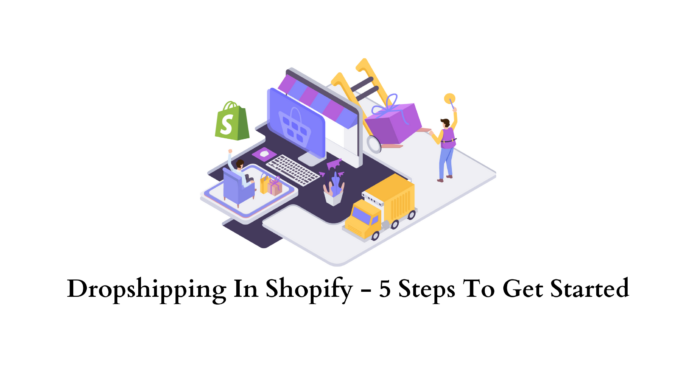You’ve heard about dropshipping and how it’s a popular business model for eCommerce entrepreneurs. The idea of building an online store without holding any inventory or shipping products yourself sounds appealing. You’re ready to dive in but need help figuring out where to start.
Don’t worry, this guide will walk you through everything you need to know to launch your own dropshipping business on Shopify. With some time and effort, dropshipping on Shopify can become a thriving business. By the end, you’ll have a fully functioning store ready to make sales. So let’s get started!
What is Dropshipping and How Does it Work?


Dropshipping is a business model where a store owner sells products but does not keep any inventory. Instead, the store owner purchases inventory as needed from a third-party supplier, who then ships the products directly to the end user. The basic steps for dropshipping are:
- Find a product to sell from a wholesale supplier.
- List the product on your Shopify store at a markup.
- When a customer purchases the product, you purchase it from the supplier.
- The supplier then packages and ships the product directly to your customer.
- You keep the difference between the wholesale and retail price as profit.
The benefits of dropshipping are that you don’t have to worry about storing products or shipping orders. You also have the flexibility to test many different products to find ones that sell well. However, you are dependent on your suppliers for quality and shipping. You’ll also likely face competition from other dropshippers selling the same products.
With some work finding the right products and marketing your store, dropshipping on Shopify can be a great way to run an eCommerce business without worrying about inventory or shipping.
Finding Reliable Dropshipping Suppliers and Products
To find products for dropshipping, you need to locate wholesale suppliers and manufacturers that offer dropshipping services. Some tips for finding good dropshipping suppliers are:
- Search online for “(product name) dropshipping supplier” or “wholesale (product name)”.
- Check supplier reviews and ratings to find reputable companies.
- Browse directories like SaleHoo, Worldwide Brands, or Dropship Access that vet dropshipping suppliers.
- Look for suppliers that offer a wide selection of products in your niche at good prices.
- Ensure the supplier has a dropshipping program and will ship single orders to your customers.
- Compare prices across a few suppliers to get the best deals.
- Order samples to assess the product and shipping quality before selling the items.
- Provide good customer support in case of any issues.
- Negotiate the best dropshipping terms and pricing you can.
Finding reputable dropshipping suppliers and quality products is key to success with Shopify dropshipping. Do the work and take the time to find great partners so you can build a sustainable business.
Setting Up Your Shopify Store for Dropshipping
To set up your Shopify store for dropshipping, follow these steps:
Step 1: Connect With Suppliers


The first thing you’ll need to do is find product suppliers who offer dropshipping. Search online for highly rated dropshipping suppliers who offer products of your interest. Once you find suppliers you want to work with, contact them to set up a dropshipping agreement.
Step 2: Add Products to Your Store


Import product images, descriptions, pricing, and other details from your suppliers into your Shopify store. You can do this manually or use a dropshipping app to automate the process. Be sure to double-check that all product information is correct before making items live in your store.
Step 3: Set Up Shipping


In your Shopify shipping settings, disable shipping for all products. Your suppliers will be handling all product fulfillment and shipping, so you do not need to calculate rates or print shipping labels. Let your customers know that shipping times may vary depending on the product supplier.
Step 4: Process Orders


Once you start getting orders, forward the customer name, address, and product details to your dropshipping supplier. They will then ship the items directly to your customer. Be sure to provide great customer service by communicating shipping time estimates and tracking information to your customers.
Step 5: Consider Feedback


Carefully review feedback and product reviews from your customers. Look for any signs that point to issues with shipping times, product quality, or customer service. Then, address these issues with your dropshipping suppliers right away to resolve any problems.
Consistently monitoring your business processes and using the right tools is key to running a successful dropshipping operation. By following these steps, you’ll be on your way to building a successful dropshipping business.
Marketing Your Dropshipping Store
Once your Shopify dropshipping store is set up, it’s time to drive traffic to it. Here are some tips and tricks to market your store:
Focus on Social Media
Promote your store on platforms like Facebook, Instagram, and Pinterest. Create social media profiles for your store, post product photos and descriptions, run contests and giveaways, and engage with your followers.
Start a Blog
A blog is a great way to boost your store’s search engine optimization (SEO) and attract organic traffic. Write blog posts about your products, industry news, and other topics relevant to your store. Link to products you sell when possible.
Run Email Marketing Campaigns
Build an email list by offering an incentive like a coupon code or free shipping. Send regular newsletters featuring sales, new products, and promotions to stay in touch with your customers.
Use Influencer Marketing
Reach out to social media influencers in your niche and offer to send them free products in exchange for an honest review and promotion to their followers.
Improve Your SEO
Optimize your product pages and blog posts by including relevant keywords, internal links, image alt text, and metadata. The higher your store ranks in search results, the more traffic you’ll get.
Consider Paid Ads
Once your organic traffic starts to increase, you can boost it further with paid advertising on platforms like Google Ads, Facebook Ads, and Instagram Ads. Even a small budget can go a long way.
Test and Optimize
Try different marketing strategies and see what works. Dropshipping success depends on constant testing and optimization.
With time and effort, you can build a continuous flow of traffic to your Shopify dropshipping store. Take your time and find the perfect combination of products and marketing to increase sales.
Top Shopify Dropshipping Apps
If you wish to skip a few steps and automate a good chunk of the work, check out a few of these Shopify dropshipping apps:
DSers


DSers is the best choice when it comes to AliExpress-related dropshipping. It allows you to import products directly from thousands of suppliers into your Shopify store, and ship directly to your customers, all in just a few clicks.
Features
- Scan AliExpress for the cheapest rates and best products.
- Easily customize and auto-update product stock and prices.
- For higher volumes, place bulk orders.
- Manage inventory and multiple stores from a single dashboard.
Price: DSers offers a free plan. If you wish to increase your inventory levels and utilize advanced features, you may choose the premium plans which start at $19.90 per month and go up to $49.90 per month.
Spocket


Spocket is another excellent choice, especially if you’re focusing on US and European suppliers. It’s great for finding unique, high-quality products and offers a smooth inventory management experience.
Features
- Choose from a large range of suppliers located in the USA and EU.
- Take advantage of discounts and no minimum order limit.
- Create branded invoicing to match your site theme.
- Round-the-clock customer support.
Price: Spocket offers a free plan and premium ones that start at $39.99 per month for a 0% transaction fee and a few more features and go up to $99.99 per month.
Printful


If you’re interested in selling custom designs, Printful should be your go-to. You create the designs, and Printful takes care of the printing, shipping, and handling. It’s like having your own printing business without the mess.
Features
- Easy to set up and use.
- Comprehensive design tools to create your custom orders.
- High-quality products and services.
- Multiple choices for packaging and branding.
Price: Printful is free to use but will charge you based on your orders and shipping.
Modalyst


Modalyst is ideal for those looking to sell high-margin products. It offers a curated list of thousands of the best dropshipping products and integrates directly with your Shopify store.
Features
- Choose from a huge range of products and print-on-demand services.
- Shipping and storage are offered in multiple locations around the globe.
- Easy to use interface.
Price: Modalyst has a free plan and premium plans that start at $35 per month and go up to $90 per month.
Inventory Source


Inventory Source is a comprehensive inventory management tool. It allows you to sync your suppliers’ inventory and automate product uploads, ensuring your store is always up-to-date.
Features
- Automatically sync orders and update your inventory from a single dashboard.
- Easy to use interface.
- Search for suppliers in the in-built directory.
- Thorough and up-to-date inventory management.
Price: Inventory Source offers a free plan. The premium plans offer a larger database of suppliers, more platform integration, bulk tools, and more. They start at $99 per month and go up to $199 per month
Conclusion
So there you have it, the steps you need to get started with Shopify dropshipping. While it may seem like a lot to take in, if you follow the process laid out here you’ll be up and running in no time.
Put in the work to find high-quality products, build a professional store, and provide great customer service. Do that and you’ll have a successful business before you know it.
We hope this guide has helped you start your dropshipping journey on Shopify!











